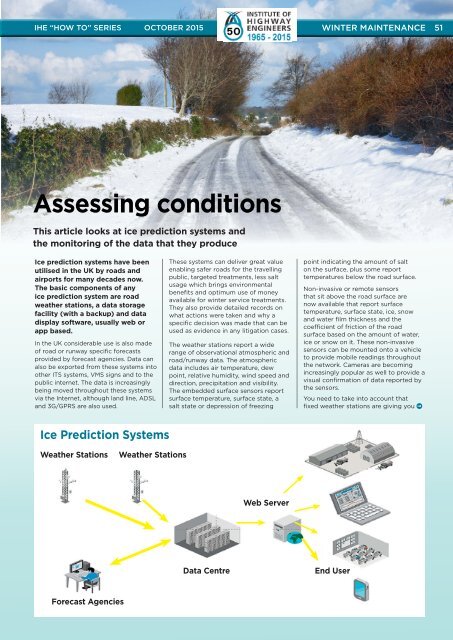Andrew Jones
Highways_October_2015
Highways_October_2015
You also want an ePaper? Increase the reach of your titles
YUMPU automatically turns print PDFs into web optimized ePapers that Google loves.
IHE www.highwaysmagazine.co.uk “HOW TO” SERIES OCTOBER 2015 OCTOBER 2015 WINTER MAINTENANCE EYEBROW 51<br />
Assessing conditions<br />
This article looks at ice prediction systems and<br />
the monitoring of the data that they produce<br />
Ice prediction systems have been<br />
utilised in the UK by roads and<br />
airports for many decades now.<br />
The basic components of any<br />
ice prediction system are road<br />
weather stations, a data storage<br />
facility (with a backup) and data<br />
display software, usually web or<br />
app based.<br />
In the UK considerable use is also made<br />
of road or runway specific forecasts<br />
provided by forecast agencies. Data can<br />
also be exported from these systems into<br />
other ITS systems, VMS signs and to the<br />
public internet. The data is increasingly<br />
being moved throughout these systems<br />
via the Internet, although land line, ADSL<br />
and 3G/GPRS are also used.<br />
These systems can deliver great value<br />
enabling safer roads for the travelling<br />
public, targeted treatments, less salt<br />
usage which brings environmental<br />
benefits and optimum use of money<br />
available for winter service treatments.<br />
They also provide detailed records on<br />
what actions were taken and why a<br />
specific decision was made that can be<br />
used as evidence in any litigation cases.<br />
The weather stations report a wide<br />
range of observational atmospheric and<br />
road/runway data. The atmospheric<br />
data includes air temperature, dew<br />
point, relative humidity, wind speed and<br />
direction, precipitation and visibility.<br />
The embedded surface sensors report<br />
surface temperature, surface state, a<br />
salt state or depression of freezing<br />
point indicating the amount of salt<br />
on the surface, plus some report<br />
temperatures below the road surface.<br />
Non-invasive or remote sensors<br />
that sit above the road surface are<br />
now available that report surface<br />
temperature, surface state, ice, snow<br />
and water film thickness and the<br />
coefficient of friction of the road<br />
surface based on the amount of water,<br />
ice or snow on it. These non-invasive<br />
sensors can be mounted onto a vehicle<br />
to provide mobile readings throughout<br />
the network. Cameras are becoming<br />
increasingly popular as well to provide a<br />
visual confirmation of data reported by<br />
the sensors.<br />
You need to take into account that<br />
fixed weather stations are giving you<br />
Ice Prediction Systems<br />
Weather Stations<br />
Weather Stations<br />
Web Server<br />
Data Centre<br />
End User<br />
Forecast Agencies



